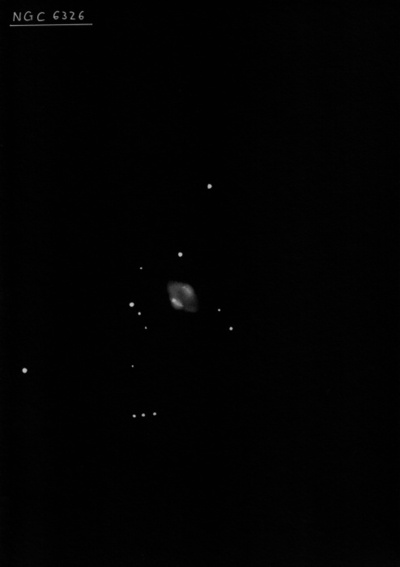
James Dunlop possibly discovered NGC 6326 = D 381 = h3675 on 26 Aug 1826 and described "an extremely faint small nebula, about 12" diameter, with a bright point in the centre." The size certainly fits, though his position was off by 24' (too far east) and this identification is uncertain.
Joihn Herschel gave two very detailed observations. On 19 Jun 1835 he logged "planetary nebula, delicate, F, vS, diam = 6 or 7 arcseconds, exactly round, perfectly uniform (as respects the graduation of the light from the centre to the edges), but the light a very little curdled. Not the slightest haziness, but like a star out of focus. 320x shows rather more fur at the edges than I think it would to a planet of equal size and light. Its light is = a star 10-11th mag. It would be quite useless to look for this object under less favourable circumstances -- of instrument and sky. A night of gloriously perfect definition! It is in a very rich place. There are 40 or 50 small stars in field. Measures of the two companions; 1st pos = 351 degrees, dist = 1 diam from edge, star = 14th mag; 2nd pos = 91.4, dist = 2/3 diam, star = 13th mag. Showed it to my attendant, J. Stone, who saw it well". His sketch in on Plate VI, figure 6.
In a later sweep (6 Jun 1837) the comment was added "Referring to the description of D 381, I see no ground to suppose that this can by possibility have been the object intended by that place and description. At all events the remarkable planetary character has escaped notice by the author of that description."
Joseph Turner sketched the planetary on 16 Aug 1874 using the 48" Great Melbourne Telescope. His sketch (unpublished plate VII, figure 74) shows the two nearby stars and no additional features though he noted a softness at the edges and a slight "curdling" appearance.
400/500mm - 18" (7/8/02 - Magellan Observatory, Australia): very bright, small, round compact PN in a dense field of stars. A couple of mag 13-14 stars are just off the north and east sides. At 171x and UHC filter, the crisply defined periphery is slightly elongated and evenly illuminated with no hint of a central star. The diameter appears to be ~15" with a V mag of approximately 10.5. Located 3.5° NE of gc NGC 6397 and a similar distance SSW of gc NGC 6352.
Notes by Steve Gottlieb